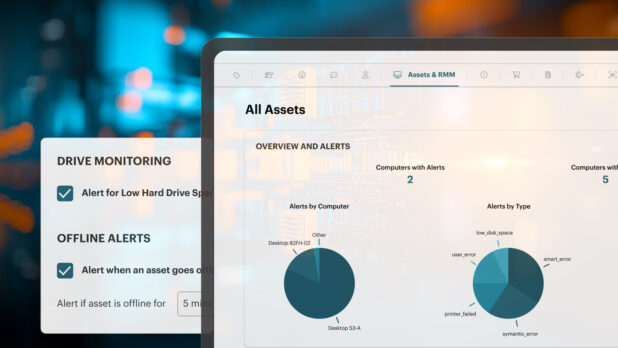Table of contents
- Why all-in-one MSP software matters for growth and efficiency
- Common challenges MSPs face with disconnected tools
- How an integrated platform changes service delivery and client experience
- Key capabilities to look for in all-in-one MSP software
- Making the business case: Cost, ROI, and long-term value
- Unlock new opportunities with all-in-one MSP software
- Frequently Asked Questions
All-in-one MSP software is the difference between scaling profitably and being overwhelmed by tool overload.
Every extra platform an MSP bolts on adds more complexity, more data silos, and more wasted hours that could be spent serving clients or driving growth. An integrated approach flips the script — simplifying operations, sharpening service delivery, and unlocking time for strategic work.
In this article, we’ll explore:
- Why all-in-one MSP software matters for efficiency and growth
- The most common challenges MSPs face with disconnected tools and systems
- How an integrated platform reshapes service delivery and the client experience
- The key capabilities every MSP should expect from an all-in-one solution
- The business case for adoption, including cost, ROI, and long-term value
- How MSPs can unlock new opportunities by rethinking their tech stack
Why all-in-one MSP software matters for growth and efficiency
For managed service providers, efficiency isn’t just about saving time — it’s the foundation for profitability and sustainable growth.
When teams rely on multiple disconnected tools to manage tickets, billing, monitoring, and client communications, the result is duplication, missed details, and slower response times. Every inefficiency compounds, eating into margins and limiting the ability to scale.
Recent research backs this up. A 2024 survey found the average MSP manages five separate security tools, while nearly one in five juggle seven to ten, and only 11% say their stack integrates seamlessly. The fragmentation doesn’t just create headaches; it directly impacts profitability. Half of MSP executives report that current project management practices — often made worse by tool sprawl — are impairing their bottom line.
All-in-one MSP software changes that dynamic by consolidating the core functions of service delivery into a single platform.
Instead of juggling logins and piecing together data from scattered systems, MSPs gain a unified workflow that keeps operations streamlined and client information accurate. This creates immediate efficiency gains while also reducing the risk of costly errors.
The real value, however, is in the growth potential. With fewer administrative roadblocks, MSPs can handle more clients without adding overhead, improve service quality to retain existing accounts, and free up staff to focus on strategic initiatives instead of repetitive tasks. Efficiency is the lever — but growth is the outcome.
Common challenges MSPs face with disconnected tools
Tool sprawl has become one of the most persistent obstacles for MSPs.
Every new platform added to the stack may solve a short-term problem, but it often creates longer-term inefficiencies. Instead of enabling growth, the result is a maze of dashboards, siloed data, and manual processes that slow everything down.
Among the most common pain points:
- Data silos and inaccuracies. When billing, ticketing, monitoring, and communication tools don’t talk to each other, technicians waste time re-entering data and reconciling errors. This creates inconsistencies that can damage client trust.
- Technician inefficiency. Multiple logins and dashboards pull staff away from actual client work. Studies show the average MSP uses five security tools, and some use ten or more.
- Reduced profitability. With so much energy spent on managing tools rather than delivering services, margins suffer. Nearly half of MSP executives say inefficient project and tool management directly impairs profitability.
- Client experience challenges. Disconnected platforms make it harder to deliver fast, seamless support. Response times lengthen, reporting becomes inconsistent, and clients notice the gaps.
The irony is clear: the very tools meant to enable growth often become barriers. Without integration, MSPs risk spending more time managing their systems than managing client relationships.
How an integrated platform changes service delivery and client experience
Disconnected tools don’t just frustrate MSP staff — they also affect the clients who rely on timely, consistent service. Every delay, error, or miscommunication has a direct impact on the client experience, which ultimately determines retention and growth. By consolidating ticketing, monitoring, billing, and communication into one integrated platform, MSPs transform both their operations and their customer relationships.
The difference can be summed up in three areas: speed, consistency, and visibility. Integrated workflows shorten response times, eliminate redundant steps, and provide clients with clearer, more professional reporting. Over time, this not only reduces churn but also positions the MSP as a trusted partner rather than just a vendor.
Here’s a side-by-side view of how service delivery shifts when moving from disconnected tools to an all-in-one MSP software model:
| Area | Disconnected tools | Integrated platform (all-in-one MSP software) |
| Response times | Delays caused by switching between systems and re-entering data | Faster resolution with unified ticketing and automated workflows |
| Data accuracy | High risk of duplicate or inconsistent client records | Single source of truth across billing, monitoring, and communications |
| Technician efficiency | Time wasted logging into multiple dashboards | Streamlined workflows let staff focus on client service, not admin tasks |
| Client communication | Reports are fragmented, delayed, or inconsistent | Clear, professional reporting and proactive updates in one place |
| Client retention | Frustration from errors or slow support erodes trust | Reliable service delivery builds long-term relationships and recurring revenue |
By moving to an integrated model, MSPs free their teams from tool chaos and deliver an experience that clients immediately recognize as smoother, faster, and more reliable. That improvement in client experience directly supports growth through renewals, referrals, and upsell opportunities.
Key capabilities to look for in all-in-one MSP software
Not every platform that calls itself “all-in-one” delivers the depth MSPs need. To truly replace a disconnected stack, software should cover the core functions that drive efficiency, service quality, and profitability. When evaluating options, MSPs should focus on features that not only consolidate tools but also enhance the client experience and reduce operational risk.
Below is a breakdown of the most critical capabilities and why they matter:
| Capability | What it does | Why it matters for MSPs |
| Remote monitoring & management (RMM) | Tracks endpoints, networks, and devices in real time | Enables proactive support, reduces downtime, and improves technician utilization |
| Professional services automation (PSA) | Centralizes ticketing, scheduling, billing, and reporting | Streamlines operations, eliminates duplicate data, and creates a single source of truth |
| Integrated billing and invoicing | Automates billing tied directly to tickets and contracts | Reduces admin overhead, ensures accurate invoicing, and improves cash flow |
| Patch management | Keeps client systems up to date with security and performance updates | Lowers risk exposure, simplifies compliance, and prevents costly service interruptions |
| Asset and inventory management | Tracks client devices, software, and licenses | Improves visibility, simplifies renewals, and prevents lost revenue from unmanaged assets |
| Client communication and reporting | Provides dashboards, scheduled reports, and real-time updates | Builds client trust, demonstrates value, and supports retention and upsell opportunities |
| Automation and workflows | Automates repetitive tasks like ticket routing or alert responses | Saves time, reduces errors, and lets technicians focus on higher-value client work |
| Security integrations | Consolidates tools like AV, backup, and MFA within the platform | Reduces tool sprawl, improves compliance, and strengthens overall client protection |
An effective all-in-one MSP software solution isn’t just about checking boxes — it’s about how well these capabilities are integrated. When ticketing connects seamlessly with billing, or monitoring data feeds directly into client reports, MSPs achieve the efficiency and transparency needed to scale profitably.
Making the business case: Cost, ROI, and long-term value
For many MSPs, the hardest part of adopting all-in-one software isn’t recognizing the need — it’s justifying the investment. The reality is that sticking with disconnected tools has hidden costs: technician inefficiency, billing errors, missed SLAs, and slower client response times. These inefficiencies compound, quietly eating into profitability.
An integrated platform reframes the conversation. Instead of paying for multiple point solutions, MSPs consolidate spend into one system while gaining operational efficiency. The ROI is measured not just in dollars saved, but in growth enabled: more clients supported with the same staff, faster invoicing cycles, and higher client retention.
Key points that build the business case:
- Lower licensing costs. Instead of paying for multiple overlapping subscriptions, MSPs move to one license that covers core functions like RMM, PSA, billing, and reporting.
- Better technician utilization. When staff spend less time switching between tools or re-entering data, they have more hours available for client-facing work. This directly improves margins.
- Improved billing accuracy. Automated invoicing tied directly to tickets and contracts reduces missed billable hours and speeds up cash flow.
- Stronger client retention. With consistent service delivery and professional reporting, MSPs improve trust and reduce churn — which has a measurable impact on recurring revenue.
- Scalability without overhead. Growth no longer requires adding headcount just to manage complexity. An integrated system allows MSPs to support more clients with the same team.
The long-term value goes beyond cost savings. A unified system reduces overhead, protects margins, and creates a foundation for sustainable growth. For decision-makers, the business case is clear: investing in all-in-one MSP software isn’t just about efficiency — it’s about building a more profitable and scalable business model.
Unlock new opportunities with all-in-one MSP software
The future of managed services belongs to MSPs that run lean, efficient, and client-focused. All-in-one MSP software gives you the foundation to reduce complexity, improve margins, and deliver a service experience clients can’t walk away from.
Syncro stands out because it brings RMM, PSA, billing, automation, and reporting together in a single, intuitive platform. That means fewer logins, faster workflows, and a direct line between technician productivity and business growth.
If your team is ready to, Syncro is the all-in-one MSP software built to make that shift possible.
Ready to cut the noise of disconnected tools and build a more profitable practice?
Request a demo or start your free trial and see how Syncro’s all-in-one MSP software built to make that shift possible.
Frequently Asked Questions
All-in-one MSP software is a single platform that combines the core functions managed service providers need — such as remote monitoring and management (RMM), professional services automation (PSA), billing, patch management, and reporting. Instead of juggling multiple disconnected tools, MSPs can streamline operations, improve efficiency, and deliver a better client experience from one unified system.
Multiple point solutions create tool sprawl, data silos, and inefficiencies. MSPs often lose billable hours re-entering data, reconciling errors, or switching dashboards. All-in-one MSP software consolidates those workflows, which reduces overhead, improves technician utilization, and strengthens client trust through accurate reporting and faster response times.
With integrated ticketing, monitoring, billing, and communication, MSPs can provide faster resolutions, more consistent service, and clearer reporting. Clients notice the difference: fewer errors, proactive updates, and a smoother overall experience. This improves retention and makes upselling additional services easier.
The most important include:
- Remote monitoring and management (RMM)
- Professional services automation (PSA)
- Microsoft 365 management
- Integrated billing and invoicing
- Patch and update management
- Asset and inventory tracking
- Automation workflows
- Security integrations (backup, AV, MFA): These features ensure an MSP can run day-to-day operations, support clients proactively, and scale profitably.
Profitability improves in two ways: cost reduction and growth enablement. Consolidating point tools lowers licensing costs and admin overhead. Efficiency gains let technicians support more clients without increasing headcount. Combined with higher client retention, the ROI often exceeds the cost of adoption.
Yes. Syncro is a leading all-in-one MSP software platform that combines RMM, PSA, Microsoft 365 management, billing, and automation in one system. It helps MSPs cut tool sprawl, increase efficiency, and scale more profitably.
Share














